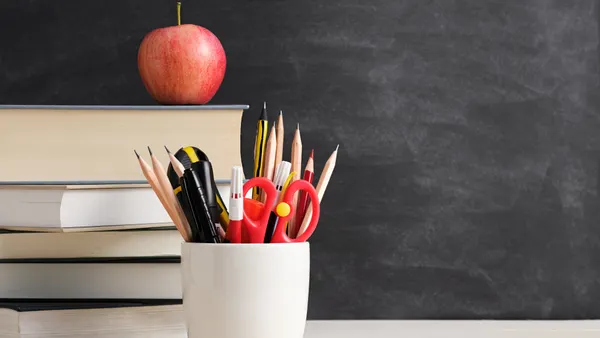Dive Brief:
- During the pandemic, 9-year-old students saw, for the first time ever, a significant decline in math scores and the most significant decline since the 1980s in reading, according to federal data released Thursday. The long-awaited data is the first nationally representative measure of the pandemic's impact on learning collected by the U.S. Department of Education.
- Reading scores declined by 5 points, from an average score of 220 in winter 2020 — prior to the pandemic — to 215 in winter 2022. Math scores declined by 7 points, from 241 in 2020 to 234 in 2022. Prior to the pandemic, while there was a nonsignificant 1-point decline in reading and 3-point decline in math scores between 2012 and 2020, the scores were still trending overall upward since the 1970s.
- The data also confirmed there were sharper declines for lower-performing students than higher-performing students, widening the pre-existing achievement gap. However, for the first time in a decade, higher-performing students' scores also declined, albeit at a slower pace.
Dive Insight:
Federal assessment experts are ringing alarm bells because of the findings.
"These results are sobering," said Peggy Carr, commissioner of the National Center for Education Statistics, which administers the National Assessment of Educational Progress, often called the nation's report card. "It's clear that COVID-19 shocked American education and stunted the academic growth of this age group of students. We don't make this statement lightly."
The results are "some of the largest declines we have observed in a single assessment cycle in 50 years of the NAEP program,” said Daniel McGrath, acting NCES associate commissioner, in a statement. Students in 2022, he said, are performing at a level last seen two decades ago.
For 9-year-olds, there was no overall increase to achievement in either subject or any growth area in the assessment. Rather, this group saw only declines or stagnant scores, Carr said. Of 9-year-olds who took the assessment, 61% were in 4th grade and 39% were in 3rd grade or below.
Some subgroups in this age group experienced even steeper declines in math, the results show.
Black 9-year-olds' math scores dropped nearly triple the points of their White counterparts, with Black students’ scores falling 13 points compared to 5 points for White students. Hispanic 9-years-olds saw an 8-point decline, a drop similar to that of White students.
In reading, however, all three racial subgroups dipped by 6 points.
The results confirm a longstanding fear among educators and researchers that the COVID-19 pandemic's school building closures significantly hurt achievement levels, especially among marginalized subgroups that didn't have consistent access to learning resources and instructors.
Seventy percent of the NAEP test-takers learned remotely during the 2020-21 school year, with higher-performing students having greater access to a learning device, a quiet place to work and a teacher available to help them with math or reading nearly every day.
“While we see declines at all performance levels, the growing gap between students at the top and those at the bottom is an important but overlooked trend," said National Assessment Governing Board member Martin West, academic dean and a professor of education at the Harvard Graduate School of Education, in a statement. "These results show that this gap widened further during the pandemic."
The governing bard has historically not answered the question of what might be causing these diverging trends, said Michael Petrilli, president of the Thomas B. Fordham Institute, a right-leaning think tank.
However, Carr emphasized the context in which these results are being released.
“School shootings, violence, and classroom disruptions are up, as are teacher and staff vacancies, absenteeism, cyberbullying, and students’ use of mental health services," Carr said in a statement. "This information provides some important context for the results we're seeing from the long-term trend assessment.”
The results stand in stark contrast to a recent study from Education Next that studied NAEP and long-term trend scores, among other assessments, and concluded that the achievement gap was narrowing prior to the pandemic.
When those findings came out in August, researchers warned the pandemic could have reversed this positive trend.
"I have to say, though, I was taken aback by the scope and the magnitude of a decline," Carr said. "I did not expect to see that much of a drop.”
The results "should remind everyone that we cannot let up in our efforts to accelerate student learning," said U.S. Secretary of Education Miguel Cardona in a statement. Some education experts have voiced concerns that districts have not invested in large-scale interventions as much as they should have and that many districts offered less programming this past summer than in 2021.
This new NAEP data should push states and districts to use federal funds for high-dosage tutoring, hiring more high-quality educators and offering after-school and summer programs to help fill gaps in students’ academic progress from the past two years, Cardona said. "This is our moment to catch our students up," he said.







 Dive Awards
Dive Awards




